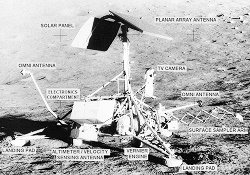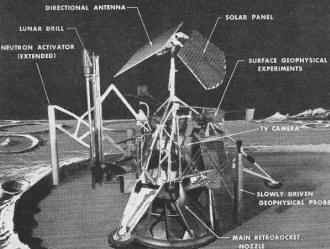|
May 1961 Radio-Electronics
 [Table of Contents] [Table of Contents]
Wax nostalgic about and learn from the history of early electronics.
See articles from Radio-Electronics,
published 1930-1988. All copyrights hereby acknowledged.
|

NASA's
Surveyor 3 lunar
probe sitting on the moon, as photographed by Apollo 12 astronauts.
NASA's Surveyor series (1 through 7) of lunar landers were launched between 1966
and 1968, following the preceding controlled-crash-landing probes Rangers 1 through
8.
This document summarizes the success and failures. Being the May 1961 issue
of Radio-Electronics magazine, the news item showing an artist's concept
drawing of the proposed Surveyor is impressively close to the final product, shown
in the photo to the left, taken by Apollo 12 astronauts after setting down
very close to it. In other news, severe smog in the Los Angeles area was found to
highly attenuate experimental communications in the 36 GHz realm, although
it had little effect below that. Looking at the International Telecommunications
Union (ITU) charts of measured
atmospheric attenuation levels, no pronounced peak under normal wet or dry conditions
occurs at 36 GHz.
New Briefs:
11/57 |
8/58 |
11/59 |
2/60 |
4/60 |
8/60 |
9/60 |
10/60 |
12/60 |
1/61 |
3/61 |
5/61 |
6/61 |
7/61 |
8/61 |
11/61 |
12/61 |
1/62 |
2/62 |
3/62 |
4/62 |
7/62 |
8/62 |
9/62 |
3/63 |
4/63 |
8/63 |
9/63 |
3/64 |
8/64 |
12/64 |
1/67 |
3/67 |
4/67 |
5/67 |
6/67 |
9/67 |
4/68 |
9/68
News Briefs
 TV Pix to Come from Moon TV Pix to Come from Moon
The Surveyor spacecraft, recently ordered from the Hughes Aircraft Co. by the
National Aeronautics and Space Administration, will carry no less than four TV cameras
to send pictures of the moon's surface back to the earth.
The Surveyor will weigh 2,500 pounds when the Centaur rocket which sends it on
its way to the moon falls away. After its retro rocket, which cushions the landing,
bums out, it will weigh 750 pounds, of which more than 200 will be scientific equipment.
The "soft" moon landing is expected to take place at about 6 miles per hour. Besides
the TV instruments, Surveyor will carry a seismometer, magnetometer, gravity-measuring
equipment, a drill designed to penetrate the surface to a depth of 5 feet, and instruments
to measure radiation and the lunar atmosphere.
Artist's idea of the Surveyor in action on the moon.
Smog Kills Higher Frequencies
Microwave signals over an 11.4-mile line-of-sight path, which came in perfectly
on clear days, faded and disappeared on days when temperature-inversion-caused smog
prevailed, California engineers discovered. The experiment was set up between the
Los Angeles City Hall and the UCLA physics building. Signals at 36,000 mc (36 gigacycles)
and higher faded, at times completely, especially when the inversion layer was below
1,000 feet and while the sun was rising.
The practical importance of the work is in setting an upper frequency limit for
radio transmission during smoggy weather. Frequencies below 36,000 mc may be considered
reliable. A less important result is the discovery that microwaves are a fast method
of measuring the height of an inversion layer, especially when between 500 and 1,000
feet.
RCA Makes "Dark Heater" Tube
Development of a new tube that operates at temperatures 20% lower than those
necessary with conventional heaters was announced recently by the RCA Electron Tube
Div. The new tubes get their name from the gray insulation coating on the heater
wire. They operate 350°K below the 1,500 to 1,700° Kelvin of the conventional
white heater.
More than a quarter million of the new tubes have been produced to date, and
they will be used in a wide variety of receiving tubes within the next few months.
They are expected to reduce the effects of ac leakage and hum, cut down the possibility
of heater damage and shorts due to changes in heater shape during warming and cooling,
and maintain stable current characteristics throughout a "greatly extended tube
life."
Lady Amateurs Gather
Annual Midwest YL Amateur Convention, sponsored by the Ladies Amateur Radio Klub
of Chicago (LARKS), will be held May 19 and 20, at Weller's Motor Lodge, 6450 W.
Touhy Ave., Chicago. The FCC has issued the call W9YL for use during the convention.
It will operate on all bands with a complete 1-kw SSB station loaned by Hallicrafters.
FCC Asks Uhf for All TV's
The Federal Communications Com-mission proposes Congressional legislation to
make all new TV receivers usable on the uhf as well as the vhf band. This, the commission
believes, would make the introduction of uhf much easier in areas where uhf stations
may be established in the future, as well as improve the situation of uhf stations
now operating in areas where there are both vhf and uhf transmitters. The cost of
including all-channel coverage in a receiver, Commissioner F. W. Ford estimated,
would be about $10 per unit. An added converter to a vhf set usually costs more,
plus installation charges and the inconvenience of an additional piece of equipment.
Transistor Hits 5 Gigacycles
A laboratory prototype transistor has been measured at a maximum oscillation
frequency of 5,000 mega-cycles, the Lansdale Div. of Philco reports.
The transistor was an MADT (micro-alloy diffused-base transistor) with a gain
of 14 db at 1,000 mc and 21 db at 420 me, with noise figures of 8 and 4 db, respectively.
The performance of the new transistor is due to careful attention to electrode
geometry, according to Dr. C. G. Thornton, Lansdale's director of research and development.
He explained that electrodes of approximately 1.5 mils in diameter and a base width
of 0.03 mil have been used. These factors, he said, plus an in-crease in surface
concentration in the region immediately adjacent to the edge of the emitter have
per-mitted a 2-to-1 reduction in the level of high-frequency base resistance.
Posted August 29, 2023
|











